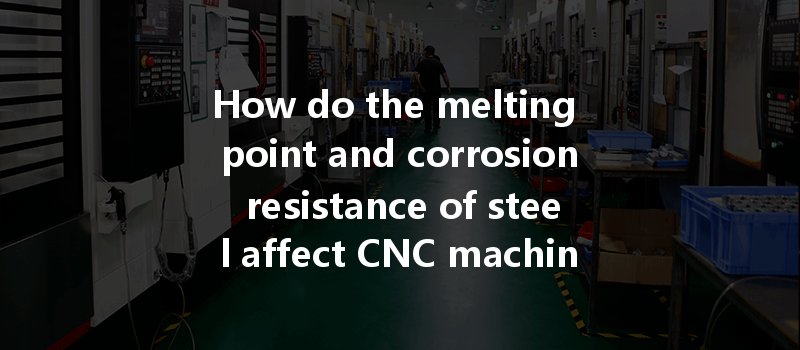Did you know that the decision-making process for selecting steel as a material in CNC machining can be compared to choosing the right ingredients for a gourmet dish? Just as the nuances of flavor can make or break a recipe, the properties of steel—particularly its melting point and corrosion resistance—can determine the success or failure of a machining operation. Understanding these properties is not just an academic exercise; it’s essential for manufacturers looking to optimize production, enhance product quality, and ensure longevity of their machined components.
In the world of CNC (Computer Numerical Control) machining, the material you choose for your projects can significantly influence your machining parameters, costs, and final product performance. This blog will delve into the intricacies of how a steel’s melting point and corrosion resistance impact CNC machining processes. We will explore the science behind these properties, provide practical solutions for challenges they pose, and offer guidance on how to select the right steel for your next CNC machining project.
The Basics of Steel Properties
Before diving deep into CNC machining, it’s vital to understand the foundational properties of steel that affect its machinability. Let’s explore melting point and corrosion resistance in more detail.
Melting Point
The melting point of a material is the temperature at which it changes from a solid to a liquid state. For steel, this point typically hovers around 2,500 °F (1,370 °C), but it varies depending on the alloy’s composition. The melting point affects CNC machining in several ways:
Corrosion Resistance
Corrosion resistance refers to the ability of steel to withstand deterioration caused by environmental factors, including moisture, chemicals, and temperature fluctuations. Different grades of steel exhibit varying levels of corrosion resistance, influenced by alloying elements such as chromium, nickel, and molybdenum.
Key impacts of corrosion resistance in CNC machining include:
Understanding the Relationship Between Melting Point and Corrosion Resistance
While melting point and corrosion resistance are separate properties, they often interact in profound ways during CNC machining. Higher melting point materials may also be inherently less corrosion-resistant, and vice versa.
For instance, stainless steel with a high melting point can be ideal for high-temperature applications but may also require additional consideration regarding corrosion resistance, especially in humid or salty environments.
Understanding this relationship enables engineers and machinists to make informed decisions about materials based on the application’s specific demands.
Challenges in CNC Machining Related to Melting Point and Corrosion Resistance
Several challenges arise when machining steel with differing melting points and levels of corrosion resistance. Below, we explore these challenges and present effective solutions.
Challenge: Machining materials with high melting points can lead to rapid tool wear, especially if the tooling materials are not adequately heat-resistant.
Solution:
Challenge: Excessive heat can lead to thermal expansion, warping, and even softening of the workpiece material, hampering accuracy.

Solution:
Challenge: Materials with poor corrosion resistance can corrode rapidly under machining conditions, leading to poor surface finishes and dimensional inaccuracies.
Solution:
Challenge: Corrosion can introduce defects into machined parts, particularly in environments rife with moisture and chemicals.
Solution:
Selecting the Right Steel for CNC Machining
Choosing the right grade of steel for CNC machining is fundamental. Below are some key considerations to aid in material selection based on melting point and corrosion resistance.
Understanding the end-use of the machined component can significantly streamline material selection. Considerations include:
Utilize material databases, such as the ASM Handbook or online steel specifications, to review the mechanical and thermal properties of different steel grades. This allows you to compare melting points, corrosion resistance, and other critical factors.
While some corrosion-resistant steels may come at a premium, long-term durability and reduced maintenance can ultimately lead to cost savings. Balance upfront costs with the expected lifespan of the part to make informed decisions.
If uncertainties arise, consulting material specialists or metallurgists can provide valuable insights into selecting the most suitable steel for CNC machining applications.
In conclusion, understanding the melting point and corrosion resistance of steel is vital for optimizing CNC machining processes. By recognizing how these properties influence machining outcomes, engineers and machinists can select the appropriate steel, tools, and techniques to ensure high quality, efficiency, and longevity of machined parts.
Investing time in understanding these features not only enhances the performance of CNC machined components but can also lead to significant cost savings over time. As the industry increasingly demands high-performance materials that withstand challenging environments, the importance of these factors cannot be overstated.
Next time you embark on a CNC machining project, remember to consider the melting point and corrosion resistance of steel thoughtfully. Whether it’s about achieving precise tolerances or ensuring durability, the choices you make today will pave the way for your project’s success tomorrow.






